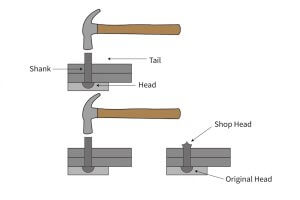Introduction to Delrin
Delrin, Polyoxymethylene (POM), known for its high tensile strength and durability, stands out in the realm of thermoplastics. Its molecular structure showcases a series of -CH2O- units, deriving from its formaldehyde polymer base. As an engineering plastic, Delrin is prized for resilience; resistance to friction, wear, and moisture adds to its unique material profile. This acetal resin exhibits low coefficient of friction and excellent dimensional stability, making it a preferred choice for precision parts, where detailed machining is crucial. Notably, it maintains its integrity over a broad temperature range, enhancing its versatility across industries.
Physical Properties of Delrin
Delrin, an acetal homopolymer, exhibits noteworthy physical properties such as strong tensile strength, high rigidity, and superior durability when compared to other thermoplastics. It maintains these characteristics even under mechanical stress and has a consistent dimensional stability. The thermal resistance of Delrin is exceptional, withstanding temperatures close to 90°C without losing form or function. When juxtaposed with similar materials like nylon or polypropylene, Delrin proves superior in terms of low moisture absorption, which enhances its thermal stability and allows for better performance in various environmental conditions.
Common Applications of Delrin in Various Industries
Delrin, with its unique blend of strength, stiffness, and durability, finds widespread use within the automotive and consumer electronics industries. The material’s remarkable fatigue resistance and low friction coefficient make it ideal for manufacturing small gear wheels, door system components, seatbelt parts, and various under-the-hood mechanisms in vehicles. Similarly, Delrin is a popular choice in consumer electronics where precision is paramount; specifically, it’s employed in making durable enclosures, switches, and connectors which benefit from its excellent dimensional stability and electrical insulating properties. As such, Delrin helps ensure reliable performance in products subjected to daily wear and tear.
Machining and Fabrication of Delrin
Delrin, a homopolymer acetal, is esteemed for its machinability compared to other engineering plastics, behaving much like soft metals in this regard due to its consistent crystalline structure. This thermoplastic achieves fine tolerances and smooth finishes with less tool wear, making it ideal for precision parts. To ensure optimal results when machining Delrin, practitioners should maintain sharp tools, use proper cooling techniques to prevent heat buildup, and avoid aggressive feeds that can cause the material to deform. For instance, employing high-speed steel (HSS) or carbide-tipped cutting tools at appropriate speeds can enhance the quality and efficiency of the machining process.
Advantages of Using Delrin in Wear Resistance and Maintenance
Delrin, a high-strength acetal homopolymer, is renowned for its excellent wear resistance paired with low friction coefficients, allowing it to excel as a material choice in applications subject to continuous or repetitive motion. This intrinsic attribute minimizes the degradation over time, ensuring components maintain their integrity longer than those made from less durable materials. The benefits extend beyond durability; lower friction equates to reduced energy consumption during operation, offering cost-effectiveness. Furthermore, Delrin’s resilience leads to fewer maintenance requirements. Its ability to resist moisture, solvents, and various chemicals means that parts do not need frequent replacement or lubrication, prolonging the lifespan of mechanisms and contributing positively towards the longevity of machinery where Delrin is utilized.
Potential Drawbacks of Delrin
While Delrin is known for its high strength, durability, and versatility in engineering applications, it may not always be the ideal material choice due to certain limitations. One primary consideration is its performance under extreme temperatures; Delrin can become brittle and lose its mechanical properties when exposed to temperatures below -40°C or above 120°C. Environmental factors also play a significant role, as Delrin, being a synthetic polymer (polyoxymethylene), poses challenges in recycling and contributes to plastic pollution if not disposed of responsibly. Additionally, in highly acidic or basic conditions, Delrin may degrade, compromising its structural integrity. Situations demanding conformability with stringent environmental standards or involving harsh chemical exposures often require alternative materials over Delrin.
Identifying Genuine Delrin Material
To differentiate genuine Delrin, a patented acetal homopolymer developed by DuPont, from other polymers, several techniques can be employed. One physical indicator is its density; Delrin typically has a density of 1.41-1.43 g/cm³ which can be measured using a simple water displacement test. Another distinguishing feature is the material’s characteristic low friction and high wear resistance; when sliding or attempting to scratch the surface, there should be minimal marking compared to other plastics. Additionally, Delrin burns with a strong, acrid smell and produces drips as it melts—traits not common to other plastics like polyethylene or PVC. A more technical approach to identification involves spectroscopy, where unique molecular fingerprints in Delrin’s spectrum set it apart from imitators. These practical tests allow for an accurate assessment of whether a material is true Delrin or a different polymer.
Care and Maintenance of Delrin Products
To ensure the longevity and performance of Delrin products, it is crucial to adhere to proper care and maintenance practices. For cleaning Delrin items, use mild soap and lukewarm water; abrasive or strong chemical cleaners can damage the material’s surface. After washing, thoroughly rinse with clean water and dry with a soft cloth to prevent water spots. When preserving Delrin components, avoid prolonged exposure to direct sunlight and high temperatures, which may cause warping or dimensional changes. Additionally, keep Delrin away from solvents such as acetone, which can compromise its mechanical properties. During storage, maintain a clean, cool environment, ideally with consistent temperature and humidity levels, and ensure that heavy objects do not compress or deform the Delrin pieces – thus safeguarding their structural integrity.
Innovations and Future of Delrin
Contemporary research on Delrin is concentrated on enhancing its mechanical properties and broadening its use in advanced engineering applications. Scientists are investigating the integration of nanomaterials to create composite materials that exhibit superior strength, durability, and resistance to wear. Such breakthroughs hint at a future where Delrin could play an integral role in sectors like aerospace for lightweight yet robust components. Potential new applications loom on the horizon, with possibilities ranging from medical devices benefiting from Delrin’s biocompatibility to electronic gadgets requiring its excellent insulating properties. Each innovation aims to maintain Delrin’s unique balance of low friction and dimensional stability while augmenting its performance envelope.
Other Articles You Might Enjoy
- What material is delrin
Introduction to Delrin Delrin, also known as Polyoxymethylene (POM), is an engineering thermoplastic commonly used in precision parts that require high stiffness, low friction, and excellent dimensional stability. Recognized for…
- Material properties of delrin
Introduction to Delrin Delrin, a trademark of DuPont, is a crystalline plastic known for its high tensile strength, stiffness, and enhanced dimensional stability. A type of acetal resin or polyoxymethylene…
- Delrin in CNC machining technology
Delrin, a trademarked name for polyoxymethylene (POM), is an engineering thermoplastic known for its high strength, rigidity, and resistance to friction and wear. This semi-crystalline plastic boasts exceptional dimensional stability…









